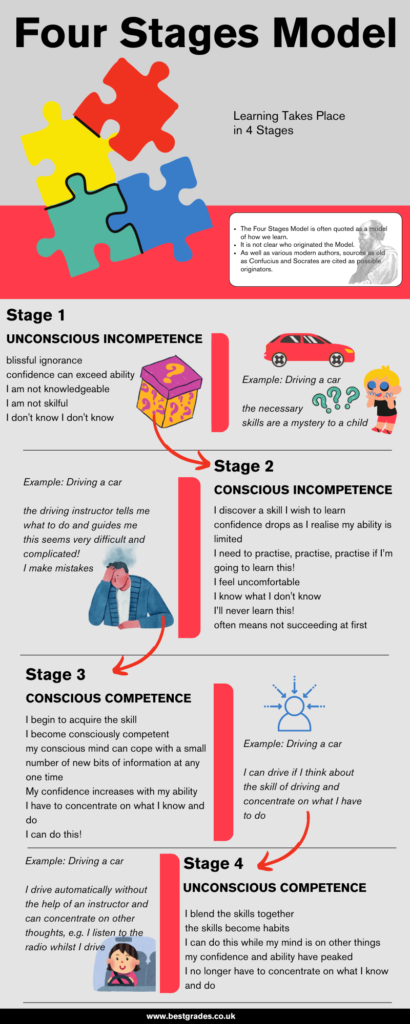
driving a car

The driver has been driving for twenty years when he has an accident and has to go back to driving school. The instructor points out that the driver does not change gears smoothly and has poor awareness of speed and distance. The instructor takes the driver back to Stage 2 or 3 in order to relearn these skills. This can be a harder or longer process than learning the first time as the old bad habits are at Stage 4 and have to removed from the driver’s system.
Alternatively, we can self-coach by determining ourselves what is wrong and by taking responsibility for improvement. This process relies on observing and assessing our performance consciously, non-judgmentally and honestly. The driver switches off the radio and concentrates on his driving. He realises that he does not change gears well, sometimes exceeds the speed limit and often drives much too closely to other vehicles. Then, he makes a conscious effort to change gear more smoothly, keep to the speed limit and keep a reasonable distance between his vehicle and the one in front of him. He thus takes himself to Stages 2 and / or 3 and takes ownership of his learning. This can be more effective and better quality learning as the driver is allowing rather than forcing the learning.
but ... how does this relate to language learning or improving communication skills?
Having awareness of the Four Stages Model is very useful for learners. Learners at Stage 2, for example, can feel overwhelmed and that they cannot learn the language or develop a skill. They give up when persistence and practice would bring them to Stages 3 and 4 and mastery. In my experience, upper-intermediate and even advanced learners of English fluctuate between Stages 3 and 4 and even between Stages 2 and 4. Performance can depend on previous learning, feedback, personal state, personal goals, the environment, relationships and the means of communication.
For instance, learner A has a client negotiation. He feels good about his English and was indeed complimented on his English by another client a couple of days ago. Yesterday he played a great round of golf, had a great meal and then got a good night’s sleep. He is well prepared for the negotiation and has a good relationship with the client. The learner enters the negotiation and is “in the zone”, using English and negotiation skills at Stage 4.
Learner B has an important business presentation in English. She doesn’t like giving presentations in her own language very much anyway and is very unsure about how her client will receive the price increases she wants to introduce. The room where she has to present is intimidating and distancing. Normally, her English is fluent and very accurate but she starts the presentation badly and soon is performing at Stage 3 and then Stage 2. She is unable to find vocabulary, hears herself making simple grammar errors and loses the structure of her presentation.
A trainer or teacher can point out persistent errors at Stage 4 and through training take the learner back through Stages 2 and 3 to relearn. For example, the trainer realises that the learner is fluent but for some reason always uses the present tense in the sentence: I am working at this company for 4 years now. The trainer points out the error and explains why we use the present perfect / present perfect continuous in this construction: I have been working at this company for 4 years now. Next, the trainer takes the learner through a number of exercises to consolidate this and corrects the learner every time he gets this particular point wrong. This is Stage 2 learning. Eventually, the learner corrects himself when making the error, Stage 3, and then ceases to make the error completely, Stage 4.
Alternatively, the learner can self-coach. If we take the two situations above, both learners A and B can analyse their performances. The negotiator can take his positive negotiating experience and consciously assess why the negotiation went so well. He can use this assessment and click into his positive behaviour the next time he feels himself performing at Stage 2 or 3. Similarly, our presenter can assess her more negative performance and decide what points she wishes to work on and take back to Stage 2 or 3 to improve future performance.
Decisions on learning can depend on personal goals. A good fluent speaker who makes a lot of mistakes with prepositions may well assess that his performance is good enough to do his job – he communicates, everybody understands him and he doesn’t need to sound like a native speaker. Even though he makes errors, he is satisfied enough to continue to work at and make errors at Stage 4. Another learner with exactly the same errors may decide she needs to work on these errors as she has to do a lot of writing in English or simply because she would like to take her English to a new level. An exam candidate could decide to consciously work on prepositions so as to achieve a greater degree of grammatical accuracy leading to a higher grade. These learners would find lots of grammar and other exercises to go back to Stages 2 and 3.
